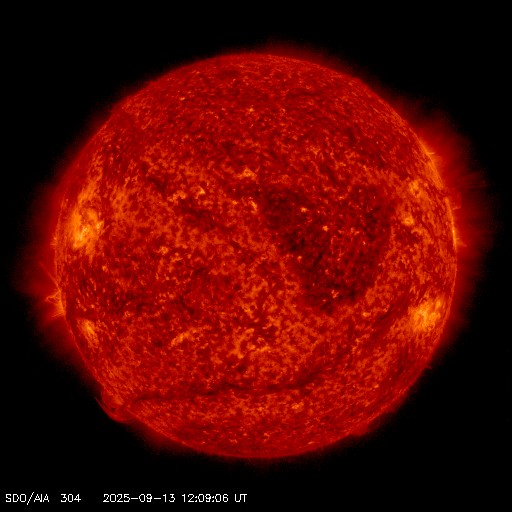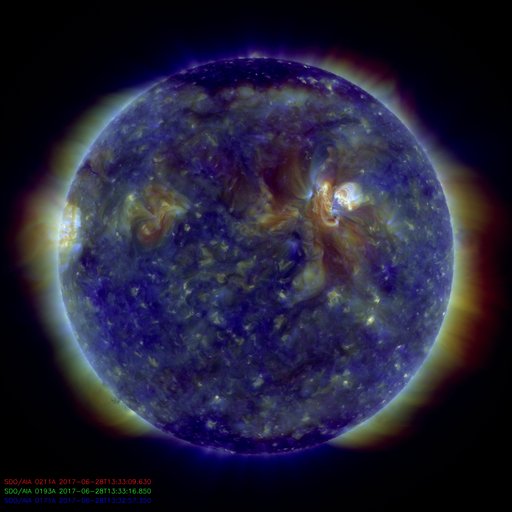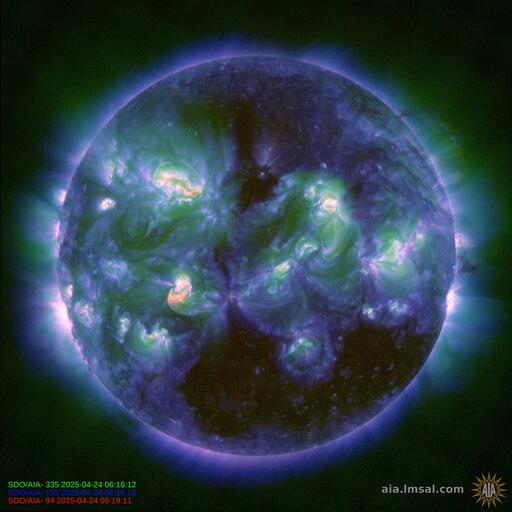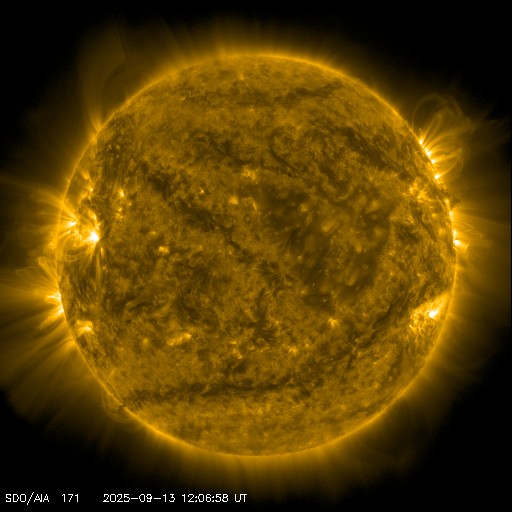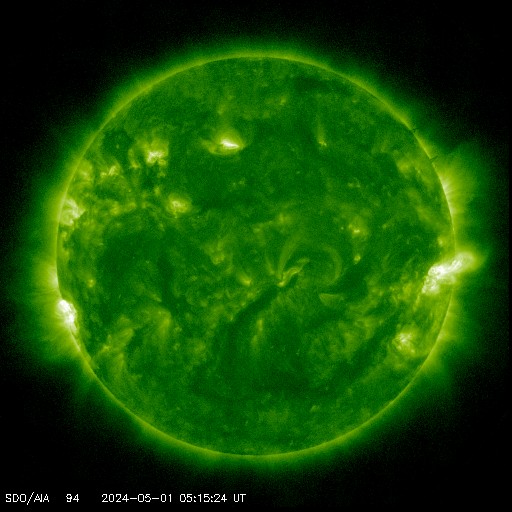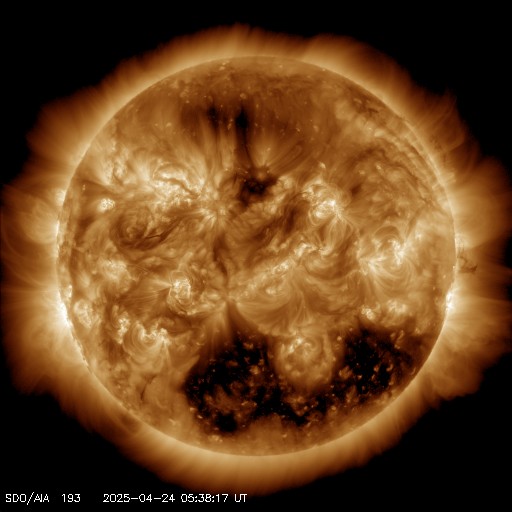On May 26, 2012 at approximately 20:47 UTC, a large backside solar eruption occured off of the far west limb of the solar disk producing a backside asymetrical halo CME observed by SOHO LASCO C/2 and C/3.This CME is not expected to be geoeffective. Along with this eruption, Type II, and Type IV radio emmissions were observed. This event began a 10 MeV proton event (NOAA Scale S1), Solar Radiation Storm, that onset May 27 05:05 UTC, with potential impacts being "Minor impacts on polar HF (high frequency) radio propagation resulting in fades at lower frequencies".
This Event was followed by a LDE (Long Duration Event), C 3.1 flare from Region 1492, lasting from 04:35 untill 07:00 UTC May 27, 2012. This LDE further elevated the proton count ending with a 10 MeV proton event that peaked at 2012 May 27 10:45 UTC, End Time: 2012 May 27 1235 UTC, Maximum 10MeV Flux: 14 pfu. Along with this LDE C class flare there was a CME eruption observed from SOHO Lasco C/2 and C/3. Although not highly Earth directed, CMEs produced from this region of the solar surface generally provide Earth with a "glancing blow", so we expect to see an uptic in geomanetic activity with its arrival May 29th - 30th.
Solar Alerts Monitoring
Monday, May 28, 2012
Wednesday, May 16, 2012
M+ Flare As GOES Xray Data Stops Updating
At 01:25 UTC Thursday, May 17 there was a significant rise in the GOES Xray flux. The rise quickly reached the M4.6 range @ 01:42 UTC coming from around sunspot region 1476. That is where the data stuck at and stopped updating. At this time, 02:17 UTC, the Xray fluc appears to still be stuck at the M4.6 range and data is still not updating. Looking at solar images for the time of the M4.6 occurred @ 01:42, and comparing the images to after the moment the Xray flux froze, it would appear that there may have been a X flare. We are still going over image data and searching for any info on why GOES stuck and stopped updating. we will post any and all info we find. Stay tuned for updates to follow.
Here we can see where the GOES Xray flux stuck and stopped updating.
GOES came back online showing data that would show we had a M5.1 solar flare peaking @ 01:47 UTC. According to the GOES data, the flare peaked 1 min after the GOES Xray flux went offline. Though we can clearly see the flare become much brighter for up to a half hour after the flare began, and even after the GOES data stopped updating. More images to come. hold tight
Thursday, May 10, 2012
M5.7 Flare + CME From Sunspot 1476 & A String Of Big C Flares

Updated @ 20:48 UTC May 10, 2012
Sunspot 1476 has not lost any steam as it turns into a direct Earth facing position. On May 11th at 04:18 UTC 1476 produced a M5.7 flare, that was closely followed by a C7.9 flare @ 05:10 and a C8.3 flare @ 05:22 UTC. It would appear that there was a CME produced in association with this M5.7 flare. The CME had a eastward direction of ejection. Because of this, more data is needed to know if this will be geoeffective or not.
Major flares are possible from 1476.
While these flares are going on, the solar winds hitting earth aer at 642km/sec, density is broken because it's saying density is at 0.1 (hahaha NOT), Bz is right now at 4.0+
geomagnetic conditions are: Unsettled.
Stay tuned to My Solar Alerts for all updates.
geomagnetic conditions are: Unsettled.
Stay tuned to My Solar Alerts for all updates.
Researchers at NASA’s Solar Dynamics Laboratory called this new region a “monster sunspot.” This region, labeled AR 1476, is gigantic in terms of sunspot regions: It measures about 60,000 miles across.
Since the sun takes 26 days to make one full revolution at the equator, the monster sunspot region will continue to be a threat to Earth for at least the next 13 days.
Credit: CNN Blog
Updated @ 20:48 UTC May 10, 2012
Sunspot 1476 has produced a M1.7 flare peaking @ 20:26 UTC. As 1476 is now in a direct earth facing position, we will continue to monitor for and report on any CME's.
SOLAR ACTIVITY INTENSIFIES: Huge sunspot AR1476 is crackling with M-class solar flares and appears to be on the verge of producing something even stronger. The sunspot's 'beta-gamma-delta' magnetic field harbors energy for X-class flares, the most powerful kind. Earth is entering the line of fire as the sunspot rotates across the face of the sun.
Credit: Spaceweather
Wednesday, May 9, 2012
M4.7 & M1.8 Solar Flare from Monster Sunspot 1476 - May 9, 2012
Monster sunspot 1476 has produced a M4.7 solar flare today peaking @ 12:32 UTC and a M1.8 flare peaking @ 14:08 UTC May 9.
For Today SWPC has given sunspot 1476 a 65% chance of producing a M flare and a 10% chance for producing a X flare.
Check back often for further updates
and alerts as today's events develop.
All updates will be added to the bottom
of this reportRegion 11476 [N10E33] has developed slowly with a strong magnetic delta structure forming in the southern part of the huge leading penumbra. Another strong delta with nearly no distance between opposite polarity umbrae is in a penumbra in the northern central part of the region. A major flare will become likely if the current development continues.
credit solen
IIB. Geophysical Activity Forecast: The geomagnetic field is
expected to be quiet to unsettled on day one (09 May). Day two (10
May) is expected to be at quiet to active levels with a chance for
minor storm periods due to the effects of the Coronal Hole High
Speed Stream (CH HSS) and the anticipated arrival of the CME that
departed the solar disk on 07 May. Day three (11 May) is expected
to return to quiet to unsettled levels as the effects of the CH HSS
begin to wane.
credit SWPC
Updated @ 21:10 UTC May 9, 2012:
1476 has produced another M Flare. A M4.1 solar flare peaking at 21:05 UTC May 9th.
Looking at the current SDO magnetogram images there is some movement seen within the middle of 1476. This could lead to more moderate to major flares in the coming hours. stay tuned.
Monday, May 7, 2012
LDE M1.9 Flare From Sunspots 1470 & 1471 Combo
We just had a LDE (long duration event) M1.9 Solar Flare peaking @ 14:31 UTC Monday May 7. This LDE flare was a result of a two punch combo from sunspots 1470 & 1471 located on the southwest area of the solar disk. CME's are often the result of a LDE event and so will be watching for signs of a CME produced in association with this event.
Check back soon for updates as more data becomes available.
Check back soon for updates as more data becomes available.
Sunday, May 6, 2012
A Closer Look At Sunspot 1476
Sunspot 1476 has now rotated into view so that were able to get a better look at how complex this new sunspot region is, so we thought now would be a good time to take a closer look. 1476 is a Beta-Gama-Delta sunspot structure that is capable of producing major flares and has a FKC classification.
F: An elongated bipolar sunspot group with penumbra on both ends. Longitudinal extent of penumbra exceeds 15 deg.
K: large, assymetric. Same structure as type 'a', but north-south diameter of penumbra is more than 2.5 degrees. Area, therefore, must be larger or equal than 250 millionths solar hemisphere.
C: compact. The area between the leading and the following ends of the spot group is populated with many strong spots, with at least one interior spot possessing mature peanumbra. The extreme case of
compact distribution has the entire spot group enveloped in one continuous prenumbral area.
Click here to view source
Click here to view source
The crew here at My Solar Alerts will be keeping a close eye on sunspot 1476 and will be reporting on any major events this new complex sunspot produces. Stay tuned :)
On a side note, SOHO LASCO C2 and C3 are not updating and we have the answer as to why.
From ESA/SOHO: SOHO went into Emergency Sun Reacquisition (ESR) mode last night (ESR-27). The cause was the same as for ESA-26 in August 2010: false trigger of the Coarse Sun Pointing Attitude Anomaly Detector (CSPAAD). SOHO is now back in Coarse Roll Pointing mode (CRP) and will stay there over the weekend. Early next week we will roll the spacecraft back to normal roll attitude.
On a side note, SOHO LASCO C2 and C3 are not updating and we have the answer as to why.
From ESA/SOHO: SOHO went into Emergency Sun Reacquisition (ESR) mode last night (ESR-27). The cause was the same as for ESA-26 in August 2010: false trigger of the Coarse Sun Pointing Attitude Anomaly Detector (CSPAAD). SOHO is now back in Coarse Roll Pointing mode (CRP) and will stay there over the weekend. Early next week we will roll the spacecraft back to normal roll attitude.
Saturday, May 5, 2012
M1.4 Flare Around New Sunspot Region 1476 - May 5 2012
2 more M flares
Today at 13:23 UTC a M1.4 solar flare occurred around sunspot region 1476. This new sunspot region is located on the far Northeastern limb of the solar disk and is today rotating into a more Earth directed position. As this region rotates over the Northeast limb, we can see it has a large leading penumbra making more major flares from 1476 possible. This will bring a rise in the quiet solar activity we have seen over the last few months. We will be keeping a close eye on the solar activity and update you all with any changes or events that occur
.
Update: Region 1476 produced 2 more M flares
A M1.3 flare peaking @ 23:02 UTC May 05 and a M1.1 flare peaking at 01:18 UTC May 06
You can view the total M & X flare Count at anytime by viewing our Solar Flare Count page HERE
We also have a very large Coronal Hole that is rotating the Earth facing side of the sun right now. The solar winds from this Coronal Hole are expected to arrive on or around May 9th
Subscribe to:
Posts (Atom)

